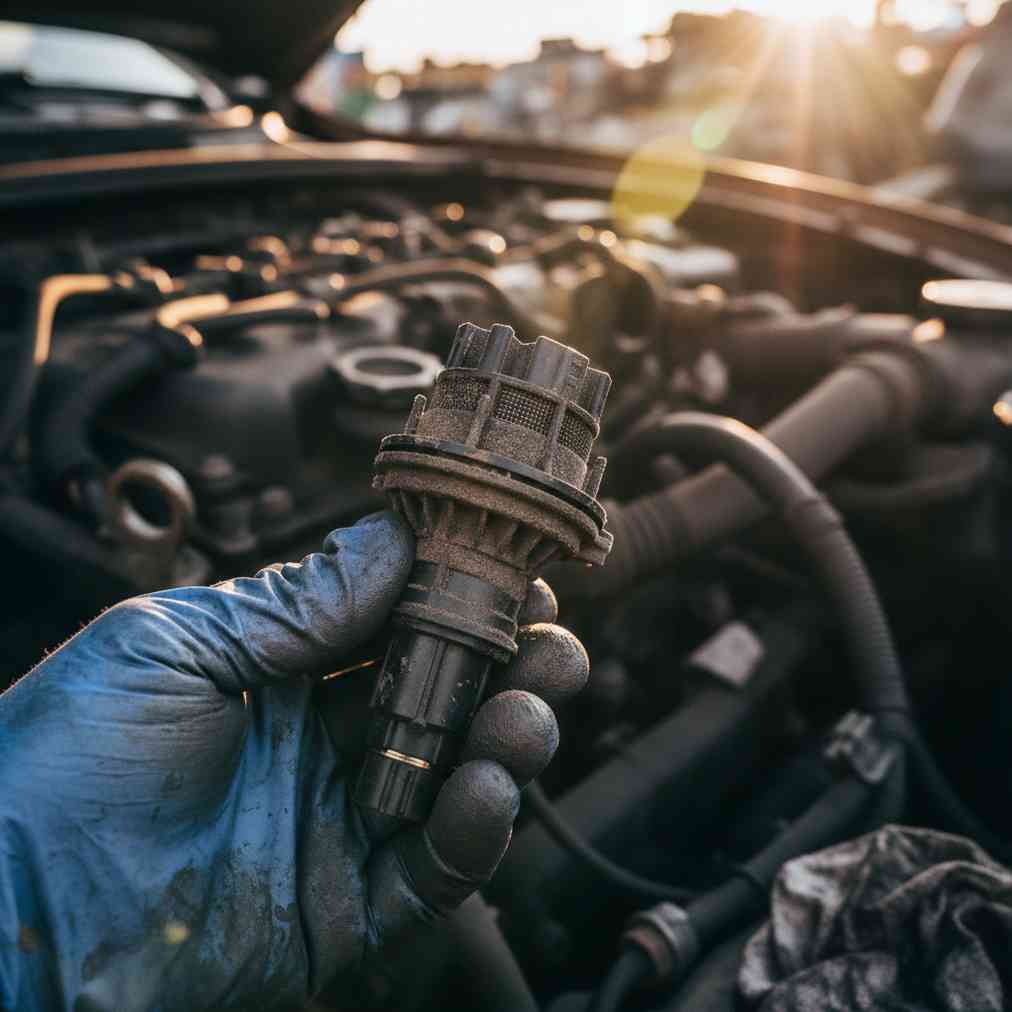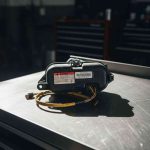Understanding the MAF Sensor and Its Role in Engine Performance
When your car starts idling roughly or struggling to accelerate, the culprit might be a faulty Mass Air Flow (MAF) sensor. This crucial engine part measures the amount of air entering your engine, helping the Engine Control Unit (ECU) determine the correct fuel mixture for optimal combustion. Understanding how to identify, locate, and purchase a quality used MAF sensor from junkyards near me can save you hundreds of dollars compared to buying new.
What Does a MAF Sensor Do?
The Mass Air Flow sensor serves as a critical communication bridge between your engine’s air intake system and its computer brain. Located in the air intake path, this sensor uses hot-wire or hot-film technology to measure the mass flow rate of air entering the engine. The ECU or Powertrain Control Module (PCM) then uses this data to calculate and deliver the precise amount of fuel needed for efficient combustion.
Modern fuel-injected engines, both gasoline and diesel, rely heavily on accurate MAF sensor readings. When this sensor fails or becomes contaminated, it can throw off the entire air-fuel mixture, leading to a cascade of performance issues that affect everything from idle quality to fuel economy.
Common Signs of MAF Sensor Failure
A failing MAF sensor typically announces itself through several noticeable symptoms. Recognizing these warning signs early can help you address the problem before it leads to more serious engine damage:
- Rough idle and misfiring – The engine struggles to maintain consistent RPMs at idle
- Poor fuel economy – Decreased miles per gallon due to incorrect fuel delivery
- Engine hesitation – Sluggish response when pressing the accelerator
- Stalling issues – Especially when coming to a complete stop
- Check Engine Light – Often accompanied by diagnostic trouble codes P0100 to P0103
- Black exhaust smoke – Indicating the engine is running too rich
Ignoring these symptoms can potentially damage other expensive parts like the catalytic converter, making early intervention crucial for your wallet and your vehicle’s longevity.
Locating Your MAF Sensor: A Step-by-Step Guide
Before you can buy a replacement MAF sensor, you need to locate and remove the existing one. The MAF sensor is typically positioned within the air intake path, making it relatively accessible for most DIY mechanics.
General Location Guidelines
- Look between the air filter box (air cleaner housing) and the intake hose leading to the throttle body
- On some vehicles, it’s integrated inside the air filter housing itself
- The sensor should be visible after opening the hood
- It will have an electrical connector with multiple wires attached
Vehicle-Specific Variations
| Vehicle Model | MAF Sensor Location |
|---|---|
| Ford F-150 (1997-2003) | Inside the air filter housing |
| Chevrolet Silverado (2007-2013) | On the intake hose |
| Modern vehicles (2016+ Ford F150 3.5L) | May use MAP sensor instead |
Important Safety Note: Before removing the sensor, disconnect the wiring harness and consider disconnecting the battery to prevent system errors or electrical damage.
Why Choose a Used MAF Sensor from Salvage Yards
Purchasing a used MAF sensor from salvage yards offers significant cost savings without sacrificing quality. New MAF sensors can cost anywhere from $150 to $400 depending on your vehicle make and model, while used alternatives from junkyards typically range from $25 to $75.
MAF sensors are relatively durable parts that often outlast the vehicles they’re installed in. Many salvaged sensors have plenty of service life remaining, especially when sourced from low-mileage donor vehicles. The key lies in knowing how to properly inspect and test these parts before purchase.
Comprehensive Inspection Checklist for Used MAF Sensors
When shopping for a used MAF sensor at salvage yards, a thorough inspection is essential. While you can’t perform a complete electrical test without installation, visual inspection can reveal most potential issues:
| Part to Inspect | What to Look For | Red Flags to Avoid |
|---|---|---|
| Sensor Wires/Film | Clean, intact heating elements | Melted wires, breakage, heavy debris coating |
| Housing/Body | Solid construction, correct part number | Cracks, deep gouges, signs of impact damage |
| Electrical Connector | Straight pins, secure locking tabs | Corroded pins, cracked housing, bent terminals |
| Wiring Harness | Intact insulation, secure connections | Frayed wires, pulled terminals, cuts in insulation |
Critical Part Number Verification
One of the most important steps when buying a used MAF sensor is verifying the part number stamped on the housing. Previous owners may have installed incorrect replacement parts, and using an incompatible sensor can cause the same performance issues you’re trying to fix. Take a photo of the part number and cross-reference it with your vehicle’s specifications before making the purchase.
Testing and Installation Considerations
While comprehensive testing requires installation in a running engine, you can perform some basic checks at the salvage yard. Advanced diagnostic techniques used in modern automotive repair can help identify potential issues before installation.
Post-Installation Requirements
- ECU Reset: Use an OBD2 scan tool to clear diagnostic trouble codes
- Test Drive: Monitor engine performance during various driving conditions
- Fuel Economy Check: Track MPG improvements over several fill-ups
- Idle Quality Assessment: Ensure smooth, consistent idle after installation
Cost Comparison: New vs. Used MAF Sensors
The financial benefits of choosing used MAF sensors become clear when comparing total costs:
| Option | Average Cost | Warranty | Installation |
|---|---|---|---|
| New OEM | $200-$400 | 1-2 years | DIY or $80-120 labor |
| New Aftermarket | $75-$200 | 6 months-1 year | DIY or $80-120 labor |
| Used from Salvage Yard | $25-$75 | 30 days (varies) | DIY recommended |
For budget-conscious vehicle owners, the savings can be substantial. A used MAF sensor that costs $40 versus a new OEM part at $300 represents an 87% cost reduction – money that can be allocated to other maintenance needs.
When to Consider Selling Your Vehicle Instead
Sometimes, multiple sensor failures and recurring electrical issues indicate deeper problems with your vehicle. If you’re facing extensive repairs beyond just the MAF sensor, it might be time to consider selling your car for cash and investing in a more reliable vehicle.
Alternative Sensor Technologies
Some newer vehicles have moved away from traditional MAF sensors in favor of Manifold Absolute Pressure (MAP) sensors with integrated Intake Air Temperature (IAT) sensors. These systems are typically located on the intake manifold rather than in the air intake tube. Modern automotive sensor technology continues evolving, making it essential to verify your vehicle’s specific configuration before shopping for replacement parts.
Environmental Benefits of Buying Used Sensors
Choosing used MAF sensors from salvage yards supports environmental sustainability by:
- Reducing electronic waste in landfills
- Minimizing manufacturing demands for new parts
- Decreasing packaging and shipping environmental impact
- Supporting the circular economy in automotive parts recycling
Final Recommendations
Fixing a rough idle with a used MAF sensor from a salvage yard can be both cost-effective and environmentally responsible. The key to success lies in thorough inspection, proper part number verification, and understanding your vehicle’s specific requirements. With proper research and careful selection, a used MAF sensor can restore your engine’s performance at a fraction of the cost of new parts.
Remember to bring basic tools to the salvage yard, take photos of part numbers for verification, and don’t rush the inspection process. A few extra minutes of careful examination can save you from purchasing a defective sensor and ensure your repair project succeeds on the first attempt.





Leave a Reply
You must be logged in to post a comment.